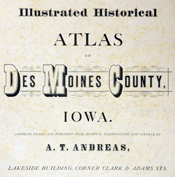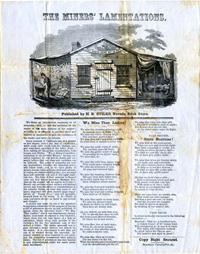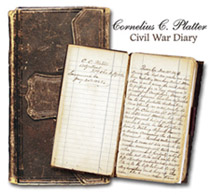 Lieutenant Cornelius C. Platter’s diary (Nov. 1864 – April 1865), which is available from the Digital Library of Georgia, provides an account of his service with the 81st Ohio Infantry Volunteers as they marched through Georgia and the Carolinas with General William T. Sherman. This diary offers an interesting perspective on life as an officer throughout this campaign. “We are entirely cut off from communication with the north and are an isolated command,” as Platter wrote on November 13, 1864. One can view the entire diary at once or select a specific section through the table of contents. The project also includes a collection of all the images from George Barnard’s Photographic Views of the Sherman Campaign (1866).
Lieutenant Cornelius C. Platter’s diary (Nov. 1864 – April 1865), which is available from the Digital Library of Georgia, provides an account of his service with the 81st Ohio Infantry Volunteers as they marched through Georgia and the Carolinas with General William T. Sherman. This diary offers an interesting perspective on life as an officer throughout this campaign. “We are entirely cut off from communication with the north and are an isolated command,” as Platter wrote on November 13, 1864. One can view the entire diary at once or select a specific section through the table of contents. The project also includes a collection of all the images from George Barnard’s Photographic Views of the Sherman Campaign (1866).
5
Feb
10
Lieutenant Cornelius C. Platter Diary (1864 – 1865)
Posted by sailerd Published in Civil War (1861-1865), Images, Letters & Diaries Themes: Battles & Soldiers3
Feb
10
Help Improve the UGRR Digital Classroom
Posted by Matthew Pinsker Published in Antebellum (1840-1861), Images, Lesson Plans, Letters & Diaries Themes: Slavery & Abolition James McPherson writes in Battle Cry of Freedom (1989) that “On all issues but one, antebellum southerners stood for state’s rights and a weak federal government” (p. 78). Yet that one exception –the fugitive slave law– was a principal cause of the coming Civil War and potentially changes one’s view of the war’s meaning. White southerners were repeatedly infuriated by signs of northern resistance to the fugitive slave law. Abolitionists even taunted them by dubbing their efforts to help runaways an “Underground Railroad.” There was essentially a low-grade border war between North and South over this issue that lasted more than a decade and drove the conflict as much as the crisis over the western territories. Not everybody, not even McPherson, sees the impact of the Underground Railroad as looming this large during the antebellum period, but most of us at the House Divided Project do. That is why the first digital classroom we created was about the Underground Railroad. Partly funded by the NEH, this site offers a host of resources, including historic documents, images, interviews with leading scholars, Google Earth field trips, dozens of K-12 lesson plans and many more tools for the classroom. Especially since this is Black History Month, I hope readers of this blog post will use this opportunity to check out or reexamine these resources and post comments below offering feedback. Everything in the House Divided Project is still in what we are calling a draft edition –all can be fixed, improved or changed as we move toward a public launch during the Civil War 150th commemoration (2011-15).
James McPherson writes in Battle Cry of Freedom (1989) that “On all issues but one, antebellum southerners stood for state’s rights and a weak federal government” (p. 78). Yet that one exception –the fugitive slave law– was a principal cause of the coming Civil War and potentially changes one’s view of the war’s meaning. White southerners were repeatedly infuriated by signs of northern resistance to the fugitive slave law. Abolitionists even taunted them by dubbing their efforts to help runaways an “Underground Railroad.” There was essentially a low-grade border war between North and South over this issue that lasted more than a decade and drove the conflict as much as the crisis over the western territories. Not everybody, not even McPherson, sees the impact of the Underground Railroad as looming this large during the antebellum period, but most of us at the House Divided Project do. That is why the first digital classroom we created was about the Underground Railroad. Partly funded by the NEH, this site offers a host of resources, including historic documents, images, interviews with leading scholars, Google Earth field trips, dozens of K-12 lesson plans and many more tools for the classroom. Especially since this is Black History Month, I hope readers of this blog post will use this opportunity to check out or reexamine these resources and post comments below offering feedback. Everything in the House Divided Project is still in what we are calling a draft edition –all can be fixed, improved or changed as we move toward a public launch during the Civil War 150th commemoration (2011-15).
3
Feb
10
Westbrook Seminary: Educating Women
Posted by sailerd Published in 19th Century (1840-1880), Images, Letters & Diaries Themes: Education & Culture “Westbrook Seminary: Educating Women” is an interesting digital exhibit available through Maine Memory Network, which is managed by the Maine Historical Society. One can read a student’s diary (1843-1844) as well as learn more about several students who attended Westbrook Seminary throughout the 19th century. Check out all of the digital exhibits on Maine Memory Network here (including “Debates Over Suffrage,” “Hannibal Hamlin of Paris Hill,” and “Irish Immigrants in Nineteenth Century Maine” )
“Westbrook Seminary: Educating Women” is an interesting digital exhibit available through Maine Memory Network, which is managed by the Maine Historical Society. One can read a student’s diary (1843-1844) as well as learn more about several students who attended Westbrook Seminary throughout the 19th century. Check out all of the digital exhibits on Maine Memory Network here (including “Debates Over Suffrage,” “Hannibal Hamlin of Paris Hill,” and “Irish Immigrants in Nineteenth Century Maine” )
2
Feb
10
Worth a Thousand Words: Photographs of Lincoln
Posted by Published in Civil War (1861-1865), Images, Lesson Plans Themes: Laws & Litigation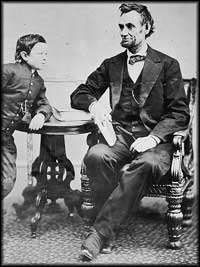 Written by Kaye Passmore and Amy Trenkle for the National Endowment for the Humanities, Picturing Lincoln is another Picturing America lesson plan. Using art as a medium to teach, students are asked to look at a photograph of Abraham Lincoln and make assessments. Later, students read a short biography of the president before exercising their creative skills in the forms of both poetry and artwork. The lesson plan is suggested for grades six through eight.
Written by Kaye Passmore and Amy Trenkle for the National Endowment for the Humanities, Picturing Lincoln is another Picturing America lesson plan. Using art as a medium to teach, students are asked to look at a photograph of Abraham Lincoln and make assessments. Later, students read a short biography of the president before exercising their creative skills in the forms of both poetry and artwork. The lesson plan is suggested for grades six through eight.
While the lesson plan offers an imaginative way for students to learn, one of the suggested extended activities, the interactive image assessment tool, allows students to become active learners. By clicking on various parts of Alexander Gardner’s February 5, 1865 photograph, students learn a fact before being encouraged to jot down any notes or questions they might have. While the activity is meant to be worked individually (with students emailing or printing out their responses), depending on individual class needs it could easily be adapted to be completed in small groups or as a whole.
1
Feb
10
Iowa Counties Historic Atlases
Posted by sailerd Published in 19th Century (1840-1880), Images, Maps Themes: Settlers & ImmigrantsThe University of Iowa’s Digital Library contains a number of different digital projects, including “Iowa Counties Historic Atlases.” One can find almost 100 county atlases published between the late 1800s and the early 1900s. Each county atlas, such as one for Des Moines county, offers different county maps, city maps, a wide variety of illustrations, and historical sketches.
29
Jan
10
Newton Chandler California Gold Rush Era Letters
Posted by sailerd Published in 19th Century (1840-1880), Letters & Diaries Themes: Settlers & Immigrants“N. A. Chandler California Gold Rush Era Letters” is a great digital project available from Claremont College. Newton Chandler (1818?-1880), who arrived in San Francisco in 1855, wrote over fifty letters to his wife between 1855 and 1872. These letters provide interesting insights into the Gold Rush, including Chandler’s journey to California in 1855. While he “had a first rate passage…[and] enjoyed it well,” Chandler explained that conditions for “deck passengers was very bad.”
27
Jan
10
Historic Iowa Children's Diaries
Posted by sailerd Published in 19th Century (1840-1880), Images, Letters & Diaries Themes: Settlers & Immigrants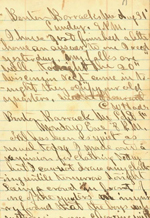 The University of Iowa has a small but interesting digital collection of diaries from children who lived in Iowa from 1860 to the 1900s. Of the eleven diaries that are available, three were written between 1860 and 1870. Even though they are relatively short (only a few pages have been digitized in some cases), the diaries can still provide interesting insights into the children’s experiences. One entry suggests that at least some children were paying attention to the important political issues of their day – Ellery Hancock, who was only about ten years old in 1860, noted on November 6 that Abraham Lincoln had been “elected.” One can learn more about the author through the short biographical sketch on the “document description” page in each diary.
The University of Iowa has a small but interesting digital collection of diaries from children who lived in Iowa from 1860 to the 1900s. Of the eleven diaries that are available, three were written between 1860 and 1870. Even though they are relatively short (only a few pages have been digitized in some cases), the diaries can still provide interesting insights into the children’s experiences. One entry suggests that at least some children were paying attention to the important political issues of their day – Ellery Hancock, who was only about ten years old in 1860, noted on November 6 that Abraham Lincoln had been “elected.” One can learn more about the author through the short biographical sketch on the “document description” page in each diary.
26
Jan
10
Teaching Civil War Era –To Judge or Not To Judge
Posted by Matthew Pinsker Published in Civil War (1861-1865), General Opinion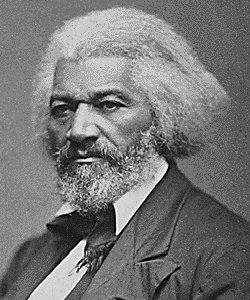 On Tuesday, January 26, 2010, I am beginning my Civil War Era history class with a quotation from Frederick Douglas at the top of my syllabus. “I shall never forget the difference,” the great activist claimed in 1894, “between those who fought for liberty and those who fought for slavery; between those who fought to save the Republic and those who fought to destroy it.” After surviving and escaping from slavery and after rising to become one of the nation’s great orators and moral visionaries, Douglass certainly earned the right to judge. But the question is … have I? Should a Civil War history professor lead off a syllabus and a semester with a comment like that one, which threatens to shatter the climate of historical objectivity and push students into making moral judgments about who was right or wrong during the Civil War era. Must they learn to condemn slavery and slaveholders, racism and racists –and most importantly, according to Douglass, treason and traitors– in order for the class to be a success? Or is it my job to encourage understanding about all sides in the conflict, regardless of how evil, cruel or stupid they might have been? I do believe in truth, but I also realize how dangerous it can be to turn historical study into an ersatz trial. My inclination is to accept an observation made several years ago by historian John Mack Faragher in the New York Times. “History is ultimately a moral art,” he told a reporter, “and it is about values. It is not merely about the collection of facts. It is about the way we put those facts together and the meaning we give them. Arguments about facts are arguments about meaning.” In other words, bring on the debate –as long as it comes rooted in evidence. But I wonder if students are really comfortable with that view or even know how to navigate historical texts and context while simultaneously arguing over values. Is it all too much, too soon? Has anyone had a classroom experience in any historical subject, but especially perhaps in the Civil War era, that might offer an answer, either as a model or as a warning?
On Tuesday, January 26, 2010, I am beginning my Civil War Era history class with a quotation from Frederick Douglas at the top of my syllabus. “I shall never forget the difference,” the great activist claimed in 1894, “between those who fought for liberty and those who fought for slavery; between those who fought to save the Republic and those who fought to destroy it.” After surviving and escaping from slavery and after rising to become one of the nation’s great orators and moral visionaries, Douglass certainly earned the right to judge. But the question is … have I? Should a Civil War history professor lead off a syllabus and a semester with a comment like that one, which threatens to shatter the climate of historical objectivity and push students into making moral judgments about who was right or wrong during the Civil War era. Must they learn to condemn slavery and slaveholders, racism and racists –and most importantly, according to Douglass, treason and traitors– in order for the class to be a success? Or is it my job to encourage understanding about all sides in the conflict, regardless of how evil, cruel or stupid they might have been? I do believe in truth, but I also realize how dangerous it can be to turn historical study into an ersatz trial. My inclination is to accept an observation made several years ago by historian John Mack Faragher in the New York Times. “History is ultimately a moral art,” he told a reporter, “and it is about values. It is not merely about the collection of facts. It is about the way we put those facts together and the meaning we give them. Arguments about facts are arguments about meaning.” In other words, bring on the debate –as long as it comes rooted in evidence. But I wonder if students are really comfortable with that view or even know how to navigate historical texts and context while simultaneously arguing over values. Is it all too much, too soon? Has anyone had a classroom experience in any historical subject, but especially perhaps in the Civil War era, that might offer an answer, either as a model or as a warning?
25
Jan
10
Emergence of Advertising in America
Posted by sailerd Published in 19th Century (1840-1880), Images, Letters & Diaries Themes: Education & Culture Duke University’s “The Emergence of Advertising in America: 1850 – 1920” is a great resource for learning more about the early advertising history in the United States. This collection, which has over 9,000 images, is organized into eleven categories – almost all of the advertisements produced before 1870 are in “Broadsides” and “Advertising Ephemera.” Yet there is still a wide variety of material from the Civil War era, as one can find broadsides for political parties (Democrat, Republican) to advertisements for hotels. If you want to find more broadsides from the Civil War, check out the Enoch Pratt Free Library’s collection, which I discussed in a previous post.
Duke University’s “The Emergence of Advertising in America: 1850 – 1920” is a great resource for learning more about the early advertising history in the United States. This collection, which has over 9,000 images, is organized into eleven categories – almost all of the advertisements produced before 1870 are in “Broadsides” and “Advertising Ephemera.” Yet there is still a wide variety of material from the Civil War era, as one can find broadsides for political parties (Democrat, Republican) to advertisements for hotels. If you want to find more broadsides from the Civil War, check out the Enoch Pratt Free Library’s collection, which I discussed in a previous post.
22
Jan
10
Sterling Family Papers
Posted by sailerd Published in Civil War (1861-1865), Letters & Diaries Themes: Battles & Soldiers, Women & Families The University of Maryland has an interesting collection of sixty two letters from a family who lived in Maryland during the Civil War. This project consists primarily of Tillie Farquhar Sterling’s correspondence with her mother, which can provide an interesting look into daily life in Maryland between 1862 and 1864. Other letters in the collection include those written by Tillie’s husband, who was an officer in the US army. In addition, the site has a short essay that provides more information on the family’s history. The New York State Library also has a collection of letters from this family, although they have not been digitized yet.
The University of Maryland has an interesting collection of sixty two letters from a family who lived in Maryland during the Civil War. This project consists primarily of Tillie Farquhar Sterling’s correspondence with her mother, which can provide an interesting look into daily life in Maryland between 1862 and 1864. Other letters in the collection include those written by Tillie’s husband, who was an officer in the US army. In addition, the site has a short essay that provides more information on the family’s history. The New York State Library also has a collection of letters from this family, although they have not been digitized yet.
